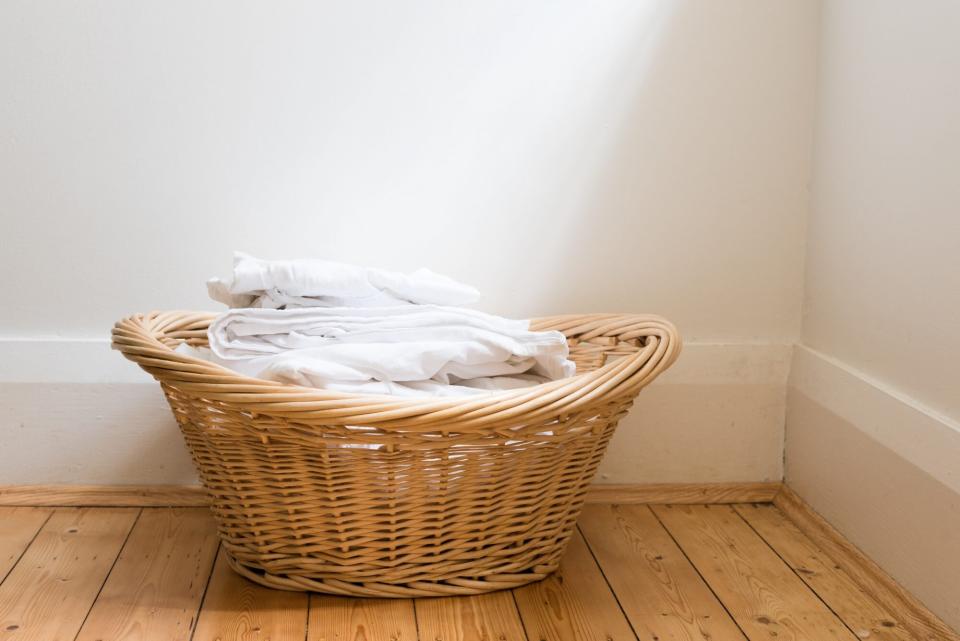How Often Should You Wash Your Sheets?

Few things feel as good as jumping into a freshly made bed and shimmying on crisp, clean sheets. This is your happy place, your sanctuary, and where you basically spend one-third of your life, so it's time to give your bed (and its linens) the treatment it deserves. Ahead, we spoke to Lindsey Boyd of The Laundress for her advice on keeping your sheets looking and feeling their best.
Related: The Best Ways to Wash All Your Bed Sheets by Fabric Type
Wash your sheets once or twice per week.
You're not in college anymore, so washing your sheets once a month doesn't fly. "Body oils, sweat, and germs build up quickly on your bedding," explains Boyd. Her recommendation: Run a load every week. If you're heavy in the sweating department, consider upping the frequency to twice weekly.
Toss them in the washing machine, and mind the temperature.
Compared to higher-maintenance wool sweaters or lacy bras, cleaning your sheets is a breeze. Toss them in the washing machine on a warm to hot cycle, and go figure out dinner. Keep in mind that hot water fades colored items faster, so use a warm to cold cycle for those pretty-patterned or dark sets. However, if you're dealing with stains (say, your child wet the bed) or if you've been sick, select the hottest cycle possible to kill germs. And when it comes to detergent, look at labels: Boyd recommends using a cleanser with plant-based surfactants. "Otherwise, it will say petroleum-based which is what you don't want," she says.
Wash your sheets separately.
As tempting as it is to just do one load and be done with it, wash your sheets separately from other items—especially towels. "The lint from the towel will get onto the sheets, and that's not something you want to deal with," warns Boyd. Throwing a stray cotton T-shirt in with your bedding is fine, but items like socks and shirts often get stuck inside the sheets and either get lost or don't get cleaned properly. Another reason to wash clothing and sheets separately is to avoid snags. "Sheets get caught on zippers and hardware, and you'll find mysterious holes and rips," says Boyd.

natalie_board / Getty Images
Spot-treat your bedding.
Who doesn't love a cup of coffee in bed—or, you know, pizza? If you get food stains on your sheets or have marks on your pillows from oil or face cream, Boyd recommends pre-treating the area with an oxygenated-bleach stain solution. "For any heavy stains, I would pre-soak before you throw it into the machine," she notes.
Dry your bed linens on medium to low heat.
"I steer away from really high heat for anything," says Boyd. She recommends a medium to low setting for drying bedding. Ten minutes before the drying cycle is over, take your sheets out. If you love a crisp bed, iron them now, while they are a little damp. We suggest the Rowenta Eco Intelligence Steam Iron ($130, walmart.com) which has a 25-percent energy savings, but ensures straight corners every time. It's harder to get the wrinkles out once sheets have cooled down.
Skip the fabric softener.
Who doesn't love the buttery-soft feel that fabric softeners provide? But while it has a lot of pros—softening your garments, helping with static, adding fresh scents, and making ironing easier—it's actually bad for certain materials, including sheets. "It's [traditionally] made of animal fat," explains Boyd, "which is so thick, it seeps into the fabric and weakens the fibers in sheets, causing holes." Don't fret. More brands like The Laundress are using plant-based formulations, which come off easily in the wash and are gentler on fabrics. When shopping for your softener, look for canola-based options or try The Laundress Fabric Conditioner ($19, thelaundress.com).
Don't forget to wash your pillows, too.
News flash: Washing your pillow case isn't enough. To remove dirt, dust, drool, and more, Boyd recommends laundering your pillows at least once a season. Place the pillow into a gentle cycle using warm or cool water and a detergent formulated for delicates. When it's time to dry, set your machine to a light—not a high heat—cycle and add wool dryer balls to fluff out the feathers so there's no clumps. "I love pillow covers," adds Boyd. "It's a case that goes over the pillow and helps from any additional oil or soil seeping into the actual feather area of the inserts. They're really inexpensive and very useful in maintaining longevity of the pillows."